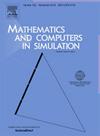A novel WENO formulation with Mach number-based adaptive numerical dissipation
IF 4.4
2区 数学
Q1 COMPUTER SCIENCE, INTERDISCIPLINARY APPLICATIONS
引用次数: 0
Abstract
The intricate dynamics of shock and discontinuity waves in fluid mechanics demand high-resolution numerical methods for accurate portrayal of multiscale features. The Weighted Essentially Non-Oscillatory (WENO) shock-capturing scheme has advanced in efficiency and precision, focusing on discontinuity regions. This paper introduces an innovative modification to WENO-Z+ and WENO-SV formulations, integrating mesh size and local Mach number as critical parameters to enhance capturing high-speed oscillations and shock-waves accurately. Extending from previous WENO variants, our formulation strategically reduces dissipation at shocks by adjusting weights for less-smooth sub-stencils. This integration of mesh size and local Mach number represents a nuanced solution for challenges posed by high-speed oscillations and shock-waves. Simulations on one and two-dimensional adiabatic and inviscid flow equations validate the efficacy of our approach, revealing good performance over established WENO formulations. Our contribution signifies a pivotal advancement, demonstrating good precision in simulating complex fluid dynamics. This integration of mesh size and local Mach number marks a significant leap towards capturing intricate fluid phenomena with utmost accuracy.
一种新的基于马赫数的自适应数值耗散WENO公式
流体力学中激波和不连续波的复杂动力学需要高分辨率的数值方法来精确描述多尺度特征。加权本质非振荡(WENO)激波捕获方案在效率和精度上都有提高,重点关注不连续区域。本文介绍了对WENO-Z+和WENO-SV公式的创新修改,将网格尺寸和局部马赫数作为关键参数,以增强对高速振荡和冲击波的准确捕获。从以前的WENO变体延伸,我们的配方通过调整不太光滑的子模板的权重,战略性地减少了冲击的耗散。这种网格尺寸和局部马赫数的集成代表了高速振荡和冲击波带来的挑战的细致解决方案。对一维和二维绝热和无粘流动方程的模拟验证了我们的方法的有效性,显示出比已建立的WENO公式更好的性能。我们的贡献标志着一个关键性的进步,在模拟复杂流体动力学方面显示出良好的精度。这种网格尺寸和局部马赫数的集成标志着以最大的精度捕获复杂的流体现象的重大飞跃。
本文章由计算机程序翻译,如有差异,请以英文原文为准。
求助全文
约1分钟内获得全文
求助全文
来源期刊

Mathematics and Computers in Simulation
数学-计算机:跨学科应用
CiteScore
8.90
自引率
4.30%
发文量
335
审稿时长
54 days
期刊介绍:
The aim of the journal is to provide an international forum for the dissemination of up-to-date information in the fields of the mathematics and computers, in particular (but not exclusively) as they apply to the dynamics of systems, their simulation and scientific computation in general. Published material ranges from short, concise research papers to more general tutorial articles.
Mathematics and Computers in Simulation, published monthly, is the official organ of IMACS, the International Association for Mathematics and Computers in Simulation (Formerly AICA). This Association, founded in 1955 and legally incorporated in 1956 is a member of FIACC (the Five International Associations Coordinating Committee), together with IFIP, IFAV, IFORS and IMEKO.
Topics covered by the journal include mathematical tools in:
•The foundations of systems modelling
•Numerical analysis and the development of algorithms for simulation
They also include considerations about computer hardware for simulation and about special software and compilers.
The journal also publishes articles concerned with specific applications of modelling and simulation in science and engineering, with relevant applied mathematics, the general philosophy of systems simulation, and their impact on disciplinary and interdisciplinary research.
The journal includes a Book Review section -- and a "News on IMACS" section that contains a Calendar of future Conferences/Events and other information about the Association.
 求助内容:
求助内容: 应助结果提醒方式:
应助结果提醒方式:


